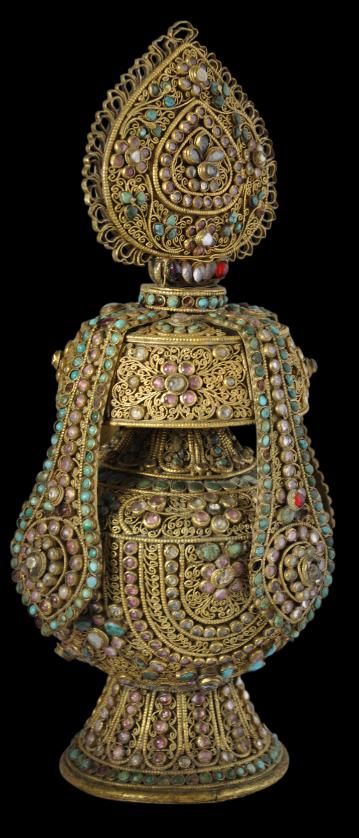
Nepalese Jewelled, Gilded Kalasha Vase & Yantra-Style Stand
Rare, Jewelled, Gilded Kalasha Vase & Yantra Stand
Nepal
18th-19th century
total height: 41cm, width: 39cm, depth: 39cm, height of kalasha vase alone: 30.5cm
This fabulous and large jewel-covered kalasha or longevity vase and matching stand is of gilded (gold-plated brass) and is decorated with applied filigree and wire-work as well as dozens of semi-precious stones in box settings. Turquoise, rubies and crystal cabochons are among the stones that have been used. Undoubtedly, there are some coloured glass cabochons used as well.
The vase itself has a globular body. Its stopper has a large tear-shaped finial that is decorated on both sides with stones. The edge is decorated with applied, open, gilded wire-work.
The top of the vase is adorned with four cascading leaf-shaped pendants embellished with turquoise and other cabochons. These symbolise the overflowing of the nectar of immortality, as well as the Buddhas of the four directions.
The vase sits on a yantra-shaped stand that is raised on four feet formed as four Himalayan Buddhistic lion inset with turquoise cabochons. The stand has a broad, scalloped, triangular fringe on each side each of which is pierced and features a kalasha vase motif amid scrolling foliage. These are the four ‘gates’ of the yantra which help to direct orientation towards the centre.
The top of the stand is pierced and engraved and has a raised dais that is shaped as and decorated on its rim with a broad lotus motif, each petal being decorated with red stone and turquoise cabochons.
The kalasha vase sits in the middle so that the lotus petals appear to radiate from it.
The base relates to part of that described as ‘a rare parcel gilt bronze yantra, attributed to 16th century Nepal and which formed lot 169 in Christie’s New York sale ‘Indian and Southeast Asian Art’, March 30, 2006. A related Nepalese gilded bronze yantra attributed to the 17th century is illustrated in Brauen (2009, p. 34).
Longevity or long life vases have no spout and are the central vases used in rituals to visualise the mandala and its divine occupants, which are then dissolved into the waters of the vase. They were made for Tibetan longevity and prosperity rituals, the attached jewels being purposeful for the notion that jewels attract jewels, including the jewel of long life.
The vase and stand is the work of a Newar craftsman most probably working for a Tibetan client. The Newar are the dominant ethnic group of the Kathmandu Valley. Metalwork and jewellery making was among their specialisations. Newar craftsmen plied their trade across the Himalayas and many items classed as Tibetan are in fact of Newari origin.
This vase and stand are in a fine, stable condition. Some stones have been lost here and there, as might be expected, and undoubtedly others are replacements.
Overall, the vase and stand are an outstanding example of this type of work. It is sculptural, rare, and highly decorative.
References
Brauen, M., et al., Mandala: Sacred Circle in Tibetan Buddhism, Arnoldsche/Rubin Museum of Art, 2009.
Clarke, J., Jewellery of Tibet and the Himalayas, V&A Publications, 2004.
Thurman, R., & D. Weldon, Sacred Symbols: The Ritual Art of Tibet, Sotheby’s/Rossi & Rossi, 1999.
Beer, R., The Encyclopedia of Tibetan Symbols and Motifs, Serindia, 2004.
Provenance
UK art market
Inventory no.: 3858
SOLD

A bejewelled kalasha attributed to the 18th century on display in the National Museum of Nepal.
Photographed in August 2011.











